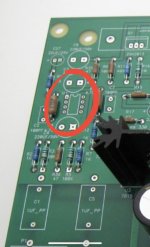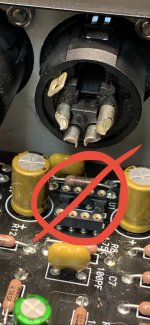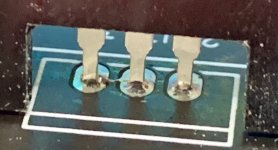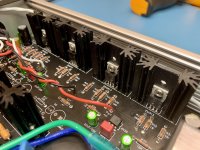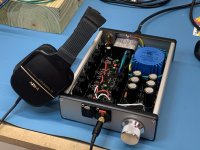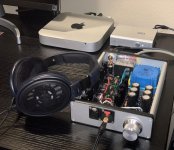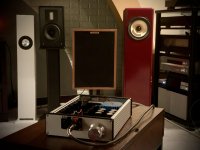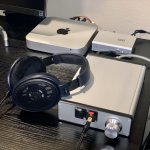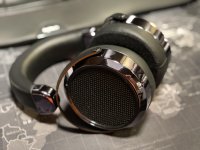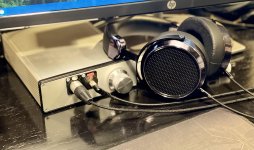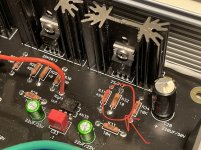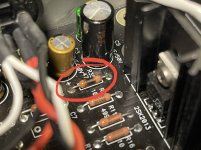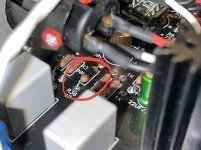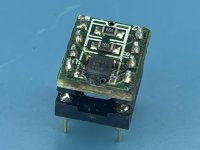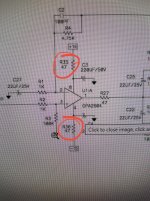Nice tidy build Chris. It's given me some motivation to finally get my Whammy boxed up. It's only been a year or so but as soon as I powered it up and heard how it sounded I left it as it was. But seeing your build has definitely prompted me to get it finished.
As much as I'd never wish for a holiday to end early, I do look forward to getting home and getting it running. 

Home from the holidays, and I was excited to get the WHAMMY up and running and give it a listen. So I installed the first opamp, plugged in my headphones, turned on some music, and all I heard was FOOMP, and then nothing. That's weird. It felt like the amp had turned full on DC, threw the driver to its endpoint and then didn't do anything. That's disappointing. When I asked dB about it, he said he usually checks any amp for DC offset before plugging headphones in since he's burned up headphones before like that. Awesome. I didn't do that. Now I'm fearing the worst.
As I'm pondering what could be wrong, I'm looking back through my entire project construction photos and comparing them to 6L6's build guide, making sure I did everything correctly. And then I noticed it: the opamp socket was installed backwards. You can stop laughing now. Of course the socket orientation doesn't affect the way the circuit works! Well, it does when you take the cue of the socket as a guide to inserting your opamp. And you install it backwards. So hoping I didn't do damage to anything else, I inspected the device and all looked well. So I reversed the device and reinserted it.
Before I put any headphones in this time, I checked the outputs with the meter to see if it was doing anything weird. And it kind of was. The voltage output was throbbing, and there was no input signal. Hmmm... What the heck is this? So I plugged in my old 1987-era Aiwa headphones I bought in Japan to see what it was doing. Just as it looked on the meter, it was throbbing like a heartbeat. Some kind of oscillation? That's bizarre. And it was pretty intense. So must it must have been something on the high power side. Then I smelled it. Hot electronic components. Broke out the IR thermometer and one of my output transistors was at about 150ºF and rising. Well isn't that special.
dB and I had a consult, and he suggested to start looking for shorts to heatsinks or otherwise. Everything measured out fine on the meter, so it must have been something high resistance that only showed up in unique circumstances. So I got under the magnifying glass and started checking out everything.
Since I picked up the device partially assembled, I looked past those parts at first glance and started looking at my own work. Everything seemed pretty normal. So I started looking elsewhere. Funny thing is I'd been working from beneath the board and everything looked fine. It didn't occur to me that a problem could be on top of the board. And there it was. A combo cold solder joint and partial bridge. A dynamic duo of problem children in one package. So I took the time to resolder all of the output transistors, making sure there was good contact on both front and back of the board.
After cleaning up my mess of flux and whatnot (I like flux. A lot.) I spun it back up and checked temps. All were normal. So this was it. Time to put in a different opamp and give it a go. I plugged in the Aiwa and prayed a little. Dead silence. I... *guess* that's a good thing. No smoke, no pop, no pulsing... Okay, the moment of truth. I turned on some Jacob Banks, slowly turned up the volume knob, and music came out. Beautiful, clean, magical music!
I listened for a few minutes with the Aiwas, but couldn't take it anymore. I had to plug in the new Senns 6XX and go for a ride. Oh my. Those who said it was a great pairing weren't lying. Lovely, lovely, lovely. And just to close the loop, I plugged in dB's HD600s with balanced plug and it was just as magical.
I'm calling this project a success! Another friend offered up a couple of other styles of opamps, and dB says he has laundry baskets full of the things. So there are new adventures in listening ahead. The current device is OPA1622 and I'll roll with that one for a while to get a feel for it and then try something different.
Thanks to all who offered guidance during this project, especially @dBel84!
To paraphrase Edgar Allan Poe: "Trust not for whom the lead flows, if not from thee."
As I'm pondering what could be wrong, I'm looking back through my entire project construction photos and comparing them to 6L6's build guide, making sure I did everything correctly. And then I noticed it: the opamp socket was installed backwards. You can stop laughing now. Of course the socket orientation doesn't affect the way the circuit works! Well, it does when you take the cue of the socket as a guide to inserting your opamp. And you install it backwards. So hoping I didn't do damage to anything else, I inspected the device and all looked well. So I reversed the device and reinserted it.
Before I put any headphones in this time, I checked the outputs with the meter to see if it was doing anything weird. And it kind of was. The voltage output was throbbing, and there was no input signal. Hmmm... What the heck is this? So I plugged in my old 1987-era Aiwa headphones I bought in Japan to see what it was doing. Just as it looked on the meter, it was throbbing like a heartbeat. Some kind of oscillation? That's bizarre. And it was pretty intense. So must it must have been something on the high power side. Then I smelled it. Hot electronic components. Broke out the IR thermometer and one of my output transistors was at about 150ºF and rising. Well isn't that special.
dB and I had a consult, and he suggested to start looking for shorts to heatsinks or otherwise. Everything measured out fine on the meter, so it must have been something high resistance that only showed up in unique circumstances. So I got under the magnifying glass and started checking out everything.
Since I picked up the device partially assembled, I looked past those parts at first glance and started looking at my own work. Everything seemed pretty normal. So I started looking elsewhere. Funny thing is I'd been working from beneath the board and everything looked fine. It didn't occur to me that a problem could be on top of the board. And there it was. A combo cold solder joint and partial bridge. A dynamic duo of problem children in one package. So I took the time to resolder all of the output transistors, making sure there was good contact on both front and back of the board.
After cleaning up my mess of flux and whatnot (I like flux. A lot.) I spun it back up and checked temps. All were normal. So this was it. Time to put in a different opamp and give it a go. I plugged in the Aiwa and prayed a little. Dead silence. I... *guess* that's a good thing. No smoke, no pop, no pulsing... Okay, the moment of truth. I turned on some Jacob Banks, slowly turned up the volume knob, and music came out. Beautiful, clean, magical music!
I listened for a few minutes with the Aiwas, but couldn't take it anymore. I had to plug in the new Senns 6XX and go for a ride. Oh my. Those who said it was a great pairing weren't lying. Lovely, lovely, lovely. And just to close the loop, I plugged in dB's HD600s with balanced plug and it was just as magical.
I'm calling this project a success! Another friend offered up a couple of other styles of opamps, and dB says he has laundry baskets full of the things. So there are new adventures in listening ahead. The current device is OPA1622 and I'll roll with that one for a while to get a feel for it and then try something different.
Thanks to all who offered guidance during this project, especially @dBel84!
To paraphrase Edgar Allan Poe: "Trust not for whom the lead flows, if not from thee."
Attachments
Last edited:
Oh, and when I say, "dB and I had a consult", what I really mean is "I whined to dB for a while about how horrible my life is and I'm just gonna die". 😀
Well done Chris! Glad you got it sorted out. After my last opamp swap I did test DC offset before plugging into phones or my system. So glad I did as both channels were showing 17V. That would have surely fried anything on the other side. Checking my opamp I realized I had cut a trace on each side of the little pcb that I had soldered the smt opamp to and that was causing the super high DC. So if that didn't confirm it, I will always use meters over speakers when testing.
If you find an opamp that bests the 1622 let us know!
If you find an opamp that bests the 1622 let us know!
Which set of speakers are you driving with this combo? And yes, I keep coming back to the WHAMMY as my main pre after all the others I’ve built. So freakin good, right?!?!
I listened to the Klipsch, TABAQ, and Selah last night. I kept going back to the TABAQ with their wee Mark Audio drivers. Incredible little speakers! I haven’t listened to the Moth Cicadas yet with this combo.
Great to know the TABAQ's can compete with the other speakers in your stable. I've been wanting to build a pair but those would be #20 on the list at this point.
Good to see your WHAMMY is up and working in Milwaukee. I was made in Milwaukee myself.
Glad to hear from you! I’m but an import, but happy to be here. 🙂
Buttoned up and in business. I tried a different opamp that a friend suggested (BB OPA2228), and while I thought it sounded nice, my ears and brain aren’t trained to listen for those subtleties (yet). I’m a recreational listener and liked what I started with just as well, so I put it back to the original configuration (OPA1622). Now she’s closed up and ready for a great life ahead.
Attachments
@dBel84 mentioned to me that Hifiman was having an open-box special on their HE560v4 headphones - normally $900US, offered at $229US. I figured that they were a good choice for my first set of planars. WHAMMY drives them quite nicely! They're a fair bit less efficient than the Drop/Sennheiser HD6XX (which are exquisite). So I do have to set the volume a fair bit higher to get the same level (if I listen to the Senns at 10:00, then the Hifimans are at 2:00). But definitely no shortage of loveliness in the sound for either.
dB and I may get together to perform one of the popular modifications for the Hifimans and see what kinds of magic we can get out of them. Thankfully the WHAMMY is up to the challenge!
dB and I may get together to perform one of the popular modifications for the Hifimans and see what kinds of magic we can get out of them. Thankfully the WHAMMY is up to the challenge!
Attachments
Last edited:
Too good a deal to pass up  and class A mosfets with planar magnetics is a synergy made in heaven. Glad to see you are enjoying them.
and class A mosfets with planar magnetics is a synergy made in heaven. Glad to see you are enjoying them.
.. dB
 and class A mosfets with planar magnetics is a synergy made in heaven. Glad to see you are enjoying them.
and class A mosfets with planar magnetics is a synergy made in heaven. Glad to see you are enjoying them... dB
To date, WHAMMY has been performing superbly! Gorgeous sounds and definition. It's never had a problem driving either my HD6XX or my newly-acquired Hifiman HE560v4.
A few days ago, I came to my desk and heard a squealing sound. While searching for its source, I realized it was coming from my headphones. I turned everything off, disconnected it, and cracked the case. As soon as I took the last screw out, the all-to-familiar smell of hot electronics filled the air.
Upon inspection, I saw that one of the output transistor supporting resistors has gotten warm. And two of the power supply resistors for the input opamp were quite roasty. And the opamp was literally toasted. Likely what caused the resistors to heat up. The resistors measured correctly, so I replaced the opamp with a different kind and the music returned, which is great news. However, after a bit of time, the resistors began to heat up and smoke, so presume that they were damaged to the point of needing to be replaced even though they read okay.
So pondering root cause here. Options:
So I'll be ordering new resistors at a minimum. The opamp power supply caps appear fine. I have other opamps to use. Output transistors appear to be unfazed. I'm happy to look at other places in the system for degraded components if you have any suggestions.
A few days ago, I came to my desk and heard a squealing sound. While searching for its source, I realized it was coming from my headphones. I turned everything off, disconnected it, and cracked the case. As soon as I took the last screw out, the all-to-familiar smell of hot electronics filled the air.
Upon inspection, I saw that one of the output transistor supporting resistors has gotten warm. And two of the power supply resistors for the input opamp were quite roasty. And the opamp was literally toasted. Likely what caused the resistors to heat up. The resistors measured correctly, so I replaced the opamp with a different kind and the music returned, which is great news. However, after a bit of time, the resistors began to heat up and smoke, so presume that they were damaged to the point of needing to be replaced even though they read okay.
So pondering root cause here. Options:
- opamp was degraded and it was only a matter of time before it failed
- Hot swapping DACs and somehow provided an unfavorable input condition that shorted the opamp, heated its power supply resistors, driving the output stage into saturation causing the squeal
- aliens
So I'll be ordering new resistors at a minimum. The opamp power supply caps appear fine. I have other opamps to use. Output transistors appear to be unfazed. I'm happy to look at other places in the system for degraded components if you have any suggestions.
Attachments
Original schematic is here:
"WHAMMY" Pass DIY headphone amp guide
Post your voltages as recommended on the schematic. I am hoping you have +/- 15VDC at the outputs of the regulators.
Make sure that nothing on the bottom of the PCB is having a direct connection to the chassis, i.e. ground and shorting the board/circuit.
I don't quite remember but do the 2SK2013 and 2SJ313 have to be isolated from the heatsink? And the heatsinks should never touch the top of the chassis? Oops, 6l6 already said in his guide: "The heatsinks are not attached electrically to the PCB, you do not need to use insulators if your TO-220 devices have metal tabs. A bit of thermal grease is extremely helpful."
But I would make sure that the heatsinks themselves are not touching the chassis, or top cover.
Best,
Anand.
"WHAMMY" Pass DIY headphone amp guide
Post your voltages as recommended on the schematic. I am hoping you have +/- 15VDC at the outputs of the regulators.
Make sure that nothing on the bottom of the PCB is having a direct connection to the chassis, i.e. ground and shorting the board/circuit.
I don't quite remember but do the 2SK2013 and 2SJ313 have to be isolated from the heatsink? And the heatsinks should never touch the top of the chassis? Oops, 6l6 already said in his guide: "The heatsinks are not attached electrically to the PCB, you do not need to use insulators if your TO-220 devices have metal tabs. A bit of thermal grease is extremely helpful."
But I would make sure that the heatsinks themselves are not touching the chassis, or top cover.
Best,
Anand.
Last edited:
- Home
- Amplifiers
- Pass Labs
- WHAMMY Headphone Amp Build from Wisconsin
